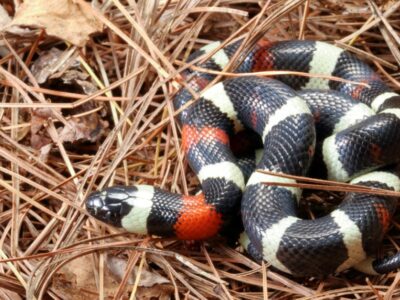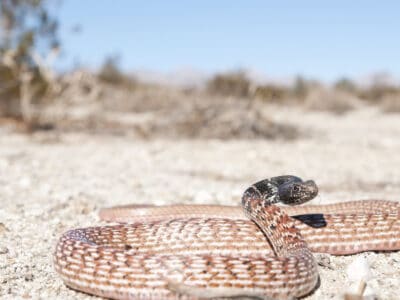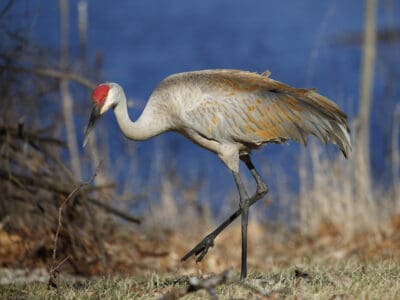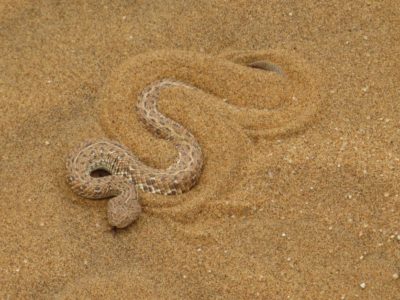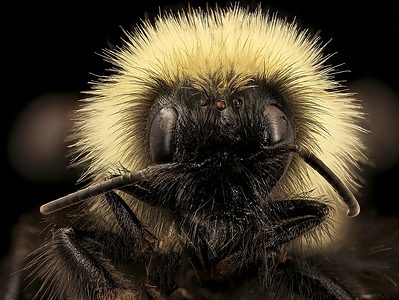When people think of Nevada, they tend to think of the Las Vegas and Reno casinos and empty stretches of desert. While Nevada does have a stunning desert, it is also home to many wild, beautiful landscapes where a surprising variety of animals thrive. These include common animals familiar to most U.S. states and Nevada’s strange native critters.
Nevada is a large southwestern state. It borders California to the east, Utah to the west, Arizona to the south, and Oregon and Idaho to the north. It is the driest state in the country. A third of the state is in the Mojave Desert.
Most of Nevada lies in the Intermountain Plateau, a region of rugged, elevated terrain bordered by the Rocky Mountains. It has more than 300 snowcapped mountain ranges broken up by wide valleys. These valleys hold 10 million acres of arid forest, hundreds of acres of marshlands, and many large lakes.
Wild Animals in Nevada
Nevada’s wild animals are those that can survive in these rugged environments. Nevada has over 4,000 animal species, including 490 birds, 52 reptiles, and dozens of rodents. While it has some animals common to the rest of the U.S., it also has strange animals found nowhere else on earth.
Its biggest predators are coyotes, mountain lions, and bobcats. Pronghorn antelope, mule deer, and elk graze in huge herds all over the state. Nevada has gray foxes, kit foxes, and Sierra Nevada red foxes.
Small mammals include bats, black-tailed jackrabbits, beavers, and river otters. Nevada’s native rodents are the Orid’s kangaroo rat, the Wyoming ground squirrel, and the yellow pine chipmunk. Ringtails, muskrats, and mountain beavers are among the other mammals you will find.
The cliffs are home to bighorn sheep, mountain goats, and mule deer. Wild horses and wild donkeys run in the desert and grasslands. Half of the wild horses in the U.S. live in Nevada.
In a desert, it’s not surprising that you would find many reptiles and amphibians. Nevada has several snake species, frogs, and turtles. It’s also home to the strange reptile known as the Gila monster. The Gila is the only venomous lizard native to the U.S.
The state has hundreds of bird and waterfowl species. Nevada’s birds include the California quail, roadrunner, Steller’s jay, and great blue heron.
The Official Animal of Nevada
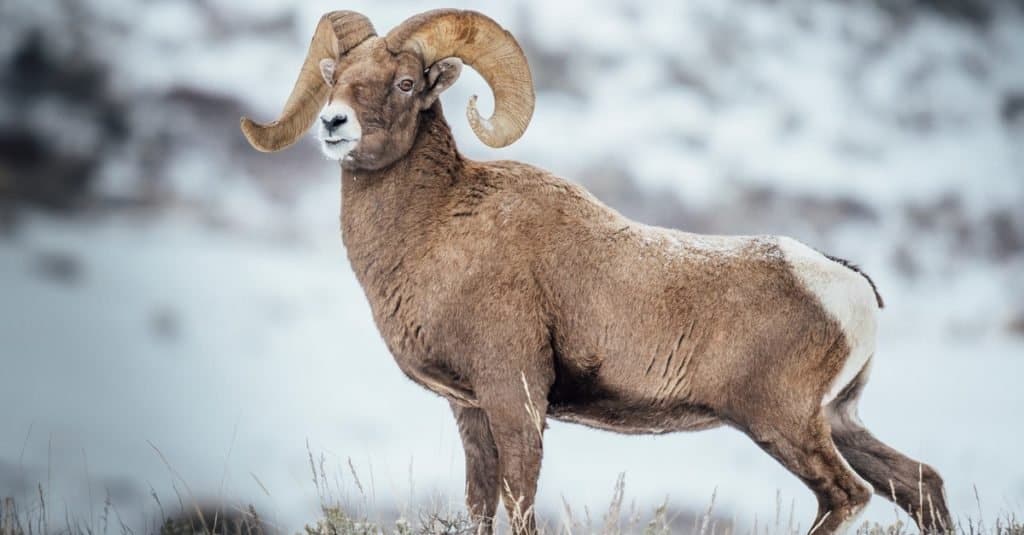
Bighorn sheep are known for their large horns which are capable of weighing 30 lbs
©John Raptosh/Shutterstock.com
Nevada’s official state animal is the desert bighorn sheep (Ovis canadensis nelson). These large, muscular sheep are uniquely adapted to a mountainous desert environment. They can go without water for several days, and they scale the mountain peaks easily.
About 12,000 of these bovids roam free in the Silver State where their specialized hooves make it easy for them to navigate the mountainous terrain with ease. Hanging around the steep rocks means they’re safe from predators which will find pursuing these nimble sheep an uphill task. Bighorn sheep are pretty gregarious and can form groups of 100. However, adult male rams prefer to form their own separate groups away from females and lambs. The former are renowned for their heavy horns which are capable of tipping the scales at 30 pounds. Mountain bluebirds are known for their bright blue plumage and live all year round in Kentucky ©MTKhaled mahmud/Shutterstock.com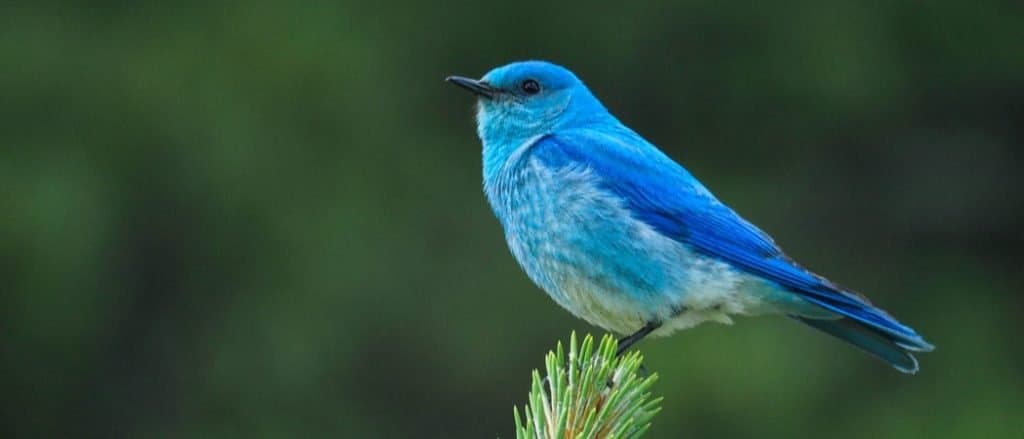
Nevada’s state bird is the mountain bluebird. A thrush and cousin of eastern and western bluebirds, it lives all year round in Nevada. The male is known for its bright blue plumage unlike the female’s which consists of muted colors. The bird is an omnivore and mainly eats insects and berries. It is also the state bird of Idaho.
Where To Find the Top Wild Animals in Nevada
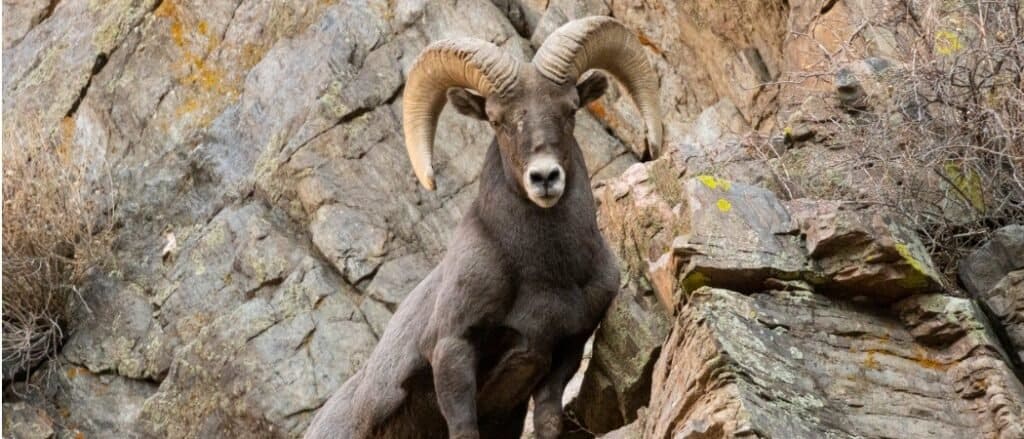
The Desert National Wildlife Refuge is the nation’s largest outside Alaska and was established to protect bighorn sheep
©iStock.com/SWKrullImaging
You don’t have to go far to see wild donkeys, wild horses, and bighorn sheep. They are everywhere in Nevada. Other animals are best viewed in one of the state’s many wildlife refuges.
Most of Nevada’s land is owned by the federal government, and millions of acres are protected by wilderness preserves, wildlife refuges, and state and national parks.
- The famous Desert National Wildlife Refuge is the country’s largest wildlife refuge outside Alaska. Established to protect desert bighorn sheep, it is now a massive complex that provides shelter to hundreds of unique animals, including the rarest and most endangered species. Natural pools inside the refuge are home to the Devil’s Hole desert pupfish, one of the rarest fish in the world, and the White River spring fish, another endemic fish.
- Stillwater National Wildlife Refuge is considered one of the best birding spots in the western part of the country. It is a protected wetlands area where more than 280 bird species stop during their southward migration. It is a protected area for dozens of waterfowl and shorebird species.
- Ruby Lake National Wildlife Refuge is a massive oasis in the middle of a dry stretch of desert. Many of the animals that find shelter here are not normally found in desert terrains. With a huge, sparkling lake and 360,000 acres of marshland, the refuge draws more than 200 shorebird species, antelopes, deer and other animals.
- Spring Mountains National Recreation Area is a great place to see native wildflowers and butterflies.
- Sheldon National Wildlife Refuge was established to protect the pronghorn antelope, which was on the brink of extinction in 1930. Today, pronghorn antelope are plentiful, and the refuge supports songbirds, mule deer, endangered fish and endangered mammals, including the pygmy rabbit.
- Red Rock Canyon Campground is a hiker’s paradise with 31 different hiking trails looping through the 195,819 acres within the Mojave Desert. Boulder Beach Campground at Lake Mead offers excellent hiking as well, where some wildlife is bound to be spotted. These are just two examples of some of the best camping near Las Vegas.
The Most Dangerous Animals in Nevada Today
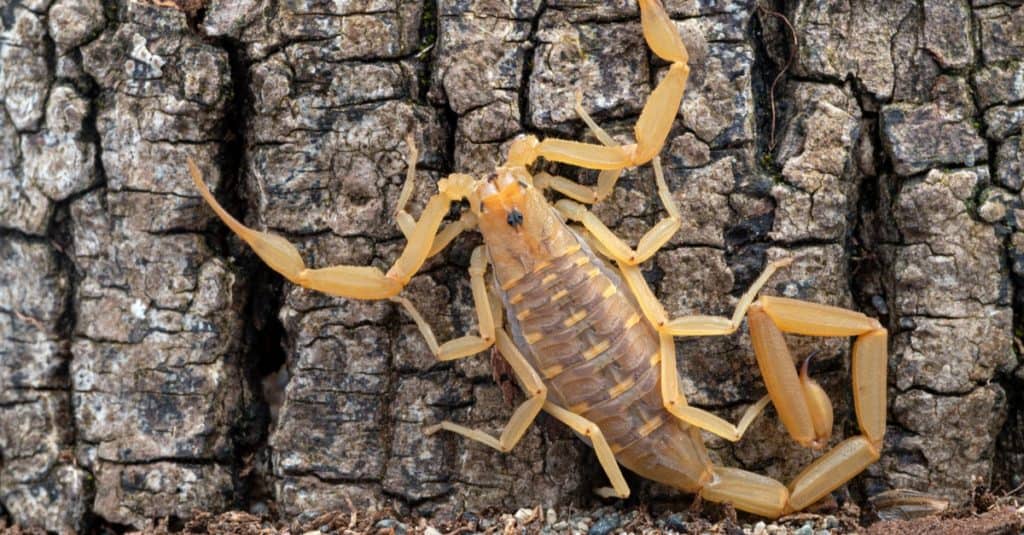
The bark scorpion is considered to be Nevada’s most dangerous animal
©Ernie Cooper/Shutterstock.com
Although Nevada has animals we view as dangerous predators, attacks on humans are rare. The most dangerous animal encounters in the state involve car crashes with wild animals. The animals hit most often include deer, wild horses, wild donkeys, and raptors.
Nevada has scorpions, rattlesnakes, ticks, and poisonous spiders, but there are few recorded deaths from these animals. According to the state’s Department of Fish and Wildlife, the most dangerous animal is the bark scorpion. The bite of this introduced scorpion species can cause severe pain, convulsions, and sweating.
The Largest Animal in Nevada
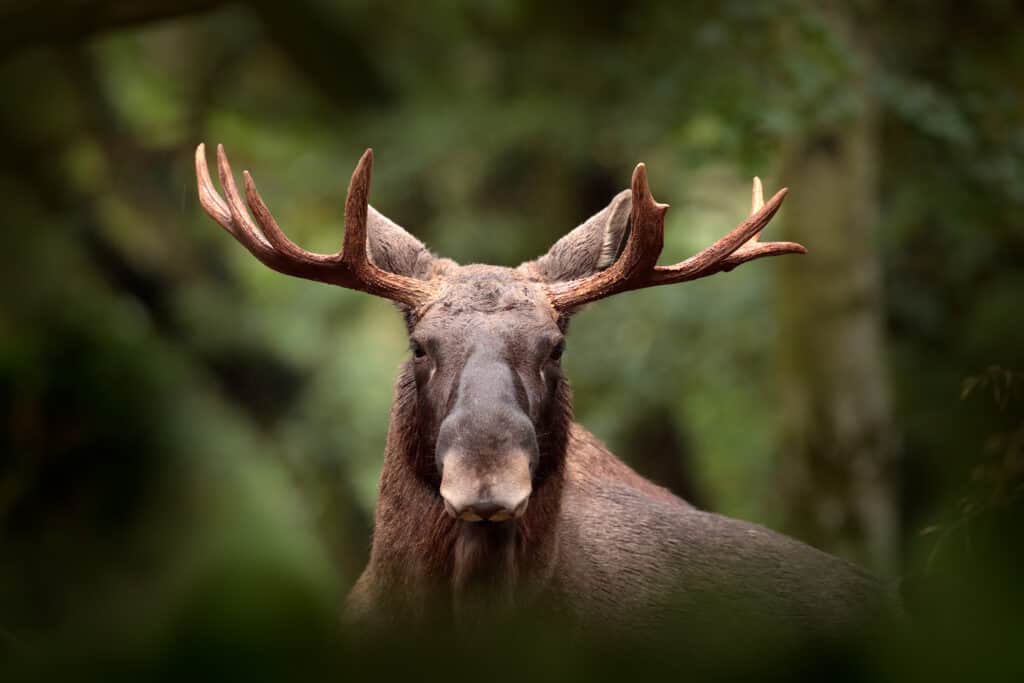
About 100 moose live in Nevada; these giant cervids seem to prefer Elko and Humboldt counties
©iStock.com/Ondrej Prosicky
The Silver State is home to about 100 moose which consider its topography to be ideal territory. These mighty cervids which are capable of reaching 6 feet 11 inches at the shoulder and weighing about 1,583 lbs, have been recently making excursions into Nevada to the delight of wildlife officials.
The herbivores in search for more spacious living quarters have begun to come from western Utah and southern Idaho. Their favorite counties are Elko and Humboldt where there’s plenty of aspen, and spruce to munch on, and no predators to pursue their young.
The Rarest Animal in Nevada
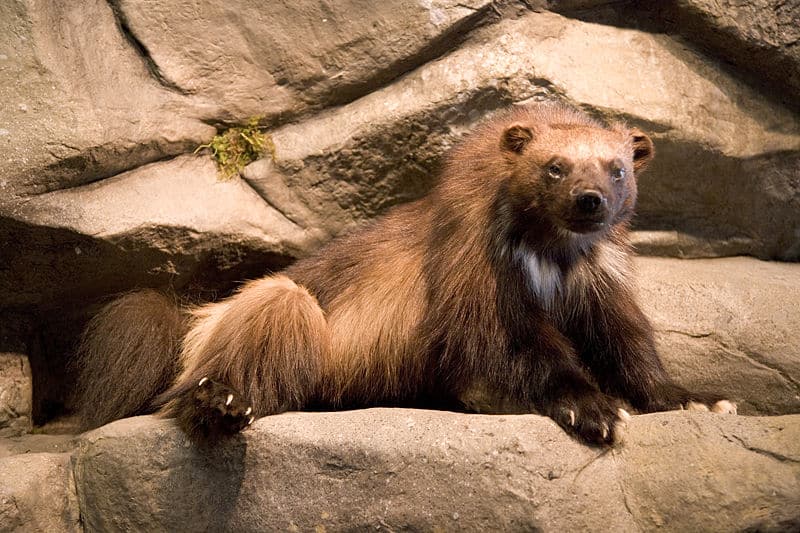
Wolverines can be found on the border between California and Nevada
©Hillebrand, Steve, Public domain, via Wikimedia Commons – License
The rarest animal in Nevada is the wolverine which once roamed the United States in large numbers. However, the largest mustelid of all, soon came into conflict with livestock herders who considered its voracious appetite for fresh beef, lamb, and poultry disturbing.
The 19th century in particular saw its numbers plummet. Interest in wolverine pelts, which were especially frost resistant, also proved to be a contributing factor. And by the 1930s the wolverine population across the United States had dwindled.
At present only 300 of these miniature ursine lookalikes exist in the North American wild. Their range also includes the border between Nevada and California, formed by the Sierra Nevada mountains. However, the species appears to have a preference for Idaho, Oregon, and Washington.
Endangered Animals in Nevada
Nevada has several animals on the endangered species list. They include:
- Least Bell’s vireo (Vireo bellii pusillus): A songbird with olive and white coloring, this avian is rather clever at creating well-concealed nests. It can also be found in Arizona, Utah, and Mexico.
- Yellow-billed cuckoo (Coccyzus americanus): This avian can be recognized by its yellow pointed beak, white chest and neck feathers, and light brown wing, head, and back feathers. This cuckoo loves to breed anywhere from Canada to Mexico.
- Clover Valley speckled dace (Rhinichthys osculus oligoporus): This adaptable little minnow which is capable of growing to two inches or slightly more, lives an insectivorous lifestyle. It can be recognized by its greenish-brown back, and pale-colored stomach.
- Railroad Valley spring fish (Crenichthys nevadae): Named for the thermal streams in the state in which they occur, these fish are noted for their lack of pelvic fins. Their limited habitat means any significant changes to it will place them at risk.
- Sierra Nevada red fox (Vulpes vulpes necator): A small size compared to other fox species and a voluminous coat differentiate this fox from its other relatives. Its especially thick coat is beneficial in enabling it to withstand the cold climes it lives in. Coyotes, drought, and wildfires constitute the main challenges to its ability to thrive.
- Desert tortoise (Gopherus agassizii): Known for its rather sedate lifestyle and a remarkable ability to tolerate imbalances in salt, water, and energy, this reptile is threatened by vehicle collisions, habitat destruction, disease, and predators.
- Mountain yellow-legged frog (Rana muscosa): This speckled amphibian whose claim to fame is the faint garlic-like odor it gives off when handled, has seen its population decline owing to the introduction of predatory trout and harmful pesticides, to its habitat.
- North American wolverine (Gula gulo luscus): This carnivore resembles a small bear, and is known for being especially voracious. The large mustelid has been the target of conservation efforts to revive its sparse population, reduced as a result of intense hunting.
- Carson wandering skipper (Pseudocopaeodes eunus obscures): Recognizable by its orange hue, this butterfly is native to Nevada and California. It is capable of growing to about three inches.
The Coldest Place in Nevada
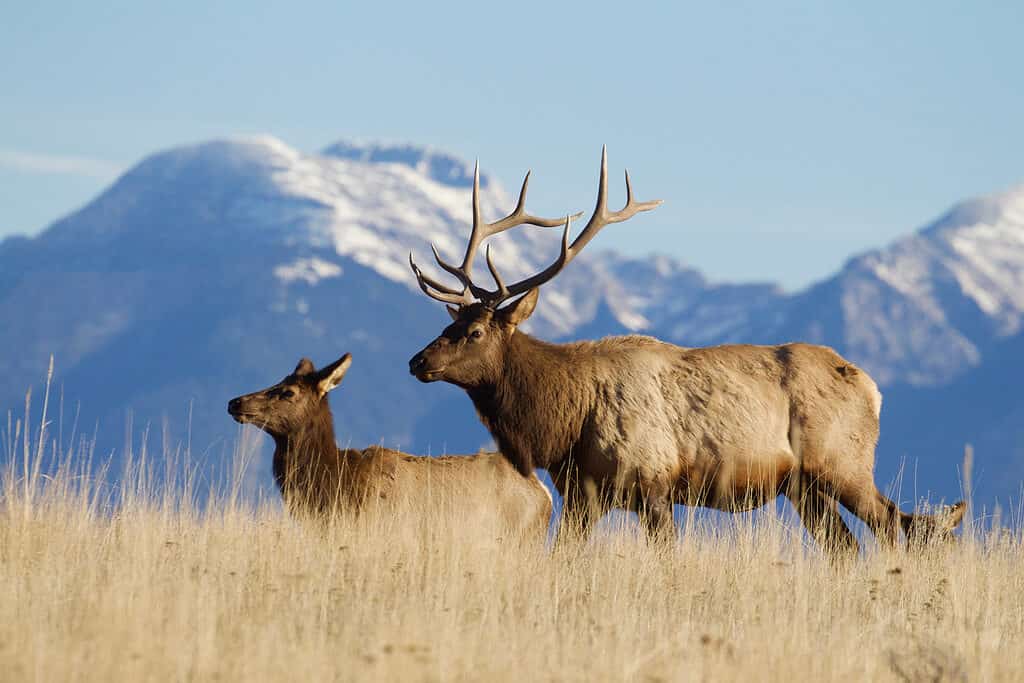
Elk can be viewed on the highway south of Ely in spring and fall
©Tom Reichner/Shutterstock.com
The coldest place in Nevada is Ely where the daily temperature often goes as low as 28.5°F. The coldest temperature reached in Ely, Nevada was −30°F which happened on February 6, 1989. Each year Ely has an average of 214.9 nights where the temperature drops below 32°F.
This mountain town with a population of 4,000 is also home to a wide variety of wildlife. Fans of the world’s largest cervid can admire elk during spring and fall, south of the city. Fans of rodents will be able to view chipmunks and black-tailed rabbits, while bird watchers will be able to view golden eagles and ravens.
Native Plants in Nevada
Nevada’s state flower is the Artemisia tridentata, commonly called big sagebrush or Great Basin sagebrush. The state is home to many other plants, some of which are endemic to the state. Some native plants in Nevada include meadow lotus, western bristlecone pine, and hairy milkweed, among others.
The state is also home to an extensive range of trees. The Utah Juniper whose cones are edible and whose needles were used as a natural remedy is especially abundant in the region. The ponderosa pine which is believed to have made its way into the region during the Last Ice Age, is a key source of excellent timber.
Nevadan Animals
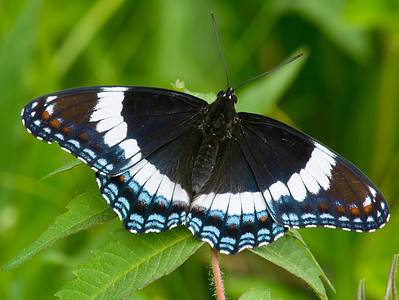
Admiral Butterfly
Stunningly beautiful wings
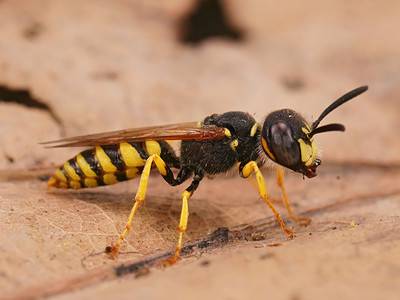
Beewolf wasp
They hunt bees
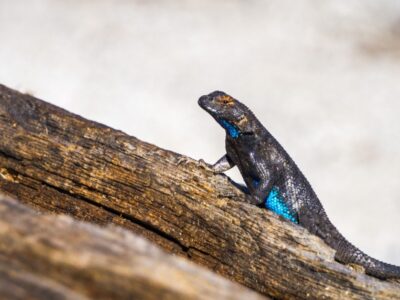
Blue Belly Lizard
This species can detach its tail to escape from predators
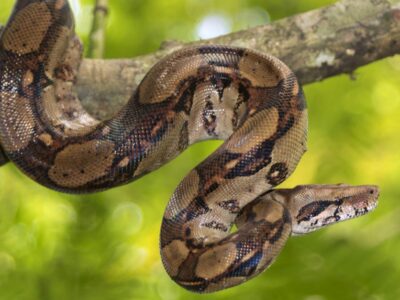
Boas
Boas are considered primitive snakes and still have vestigial legs, called spurs.
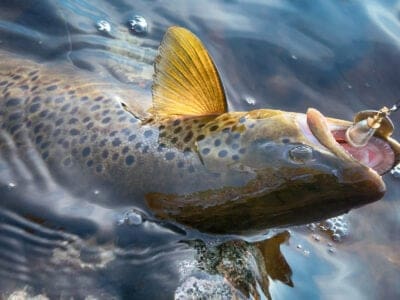
Bull Trout
The bull trout is not actually a trout, but a member of the char family.
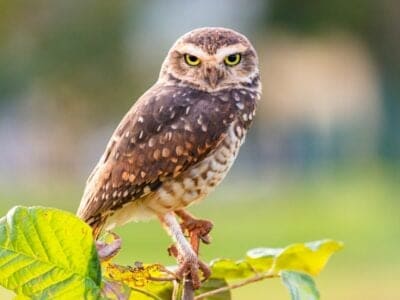
Burrowing Owl
The burrowing owl lives in underground burrows

Cactus Mouse
In hot temperatures, they lower their metabolism and become inactive to reduce the amount of water they need to survive
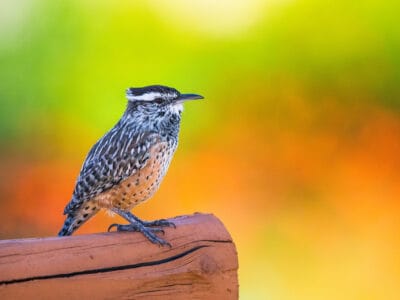
Cactus Wren
It is the largest wren in the United States
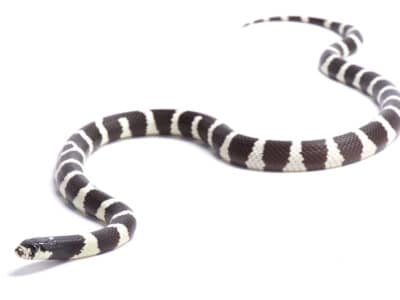
California Kingsnake
A full-grown California kingsnake can be about 3.5 feet long, though there are some cases in Mexico of the snake being almost twice this size.
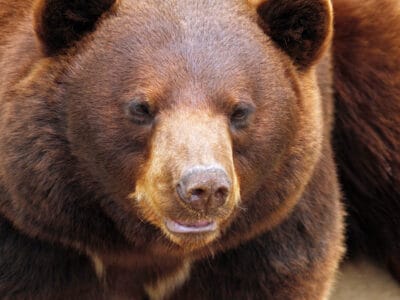
Cinnamon Bear
A newborn cinnamon bear weighs 1/2 pound -- about the same as a large apple.
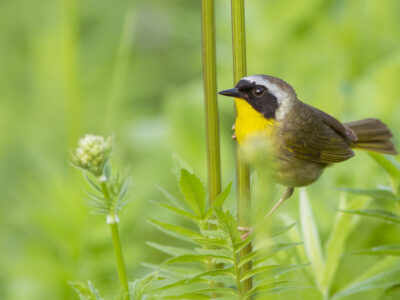
Common Yellowthroat
The Common Yellowthroat stays close to the ground and uses stealth to survive!
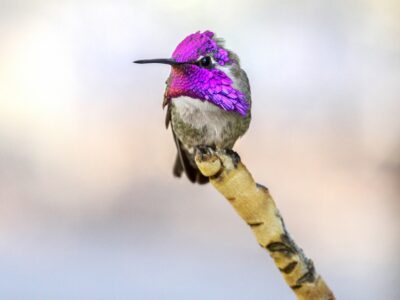
Costa’s Hummingbird
Costa's Hummingbird males have iridescent purple feathers on their heads and necks.

Flea
Adult fleas can jump up to 7 inches in the air
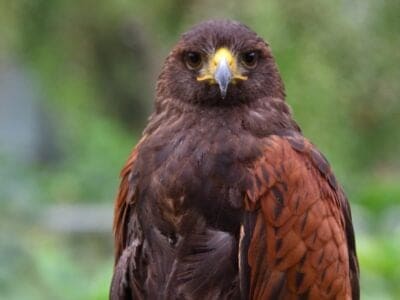
Harris’s Hawk
Their vision is eight times better than a human's
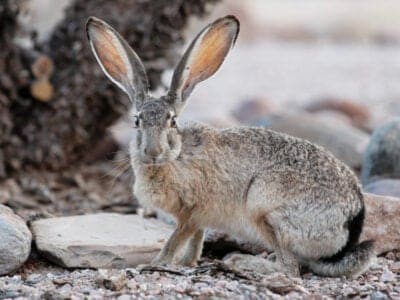
Jackrabbit
They can run as fast as 45 mph.
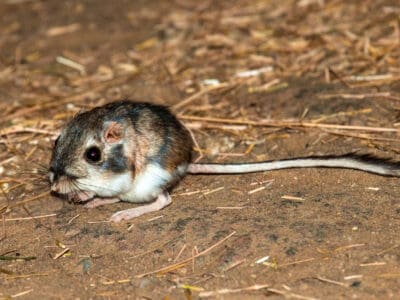
Kangaroo Mouse
The Kangaroo Mouse is a tiny mouse that stands and hops around on its hind legs, much like a kangaroo.
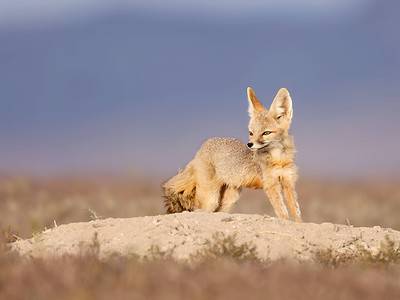
Kit Fox
The kit fox is the smallest canid in North America.
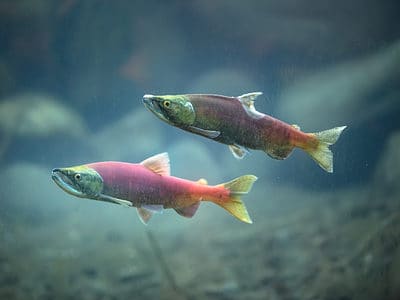
Kokanee Salmon
A non-anadromous type of sockeye salmon
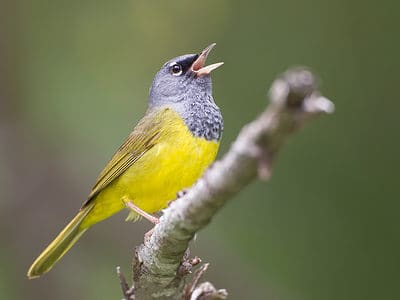
MacGillivray’s Warbler
The complicated story of how MacGillivray’s Warblers got their name involves three ornithologists, a physician and a compromise.

Mealybug
They have a symbiotic relationship with ants.
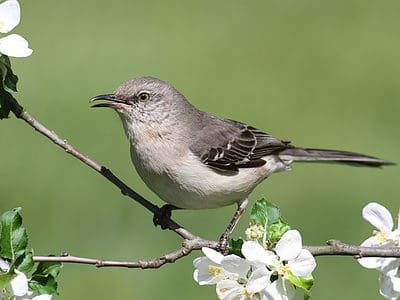
Mockingbird
Mockingbirds are incredible mimics that can learn hundreds of songs!
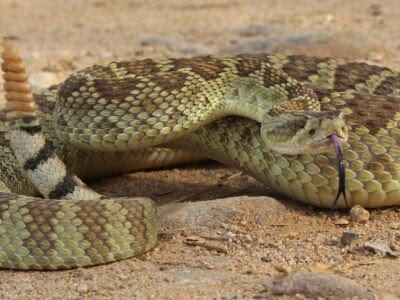
Mojave Rattlesnake
"The Mojave rattlesnake is the most venomous rattlesnake in the world."
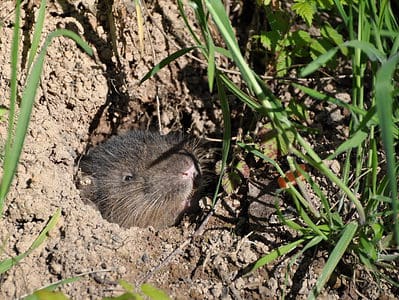
Mountain Beaver
The beaver that is not a beaver

Nematode
Nematodes range in size from 1/10 of an inch to 28 feet long

Orb Weaver
Females are about four times the size of males

Owl
The owl can rotate its head some 270 degrees
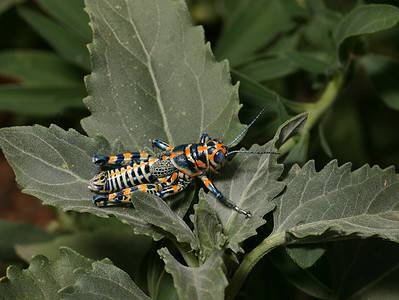
Rainbow Grasshopper (Dactylotum bicolor)
They have strikingly bright colors
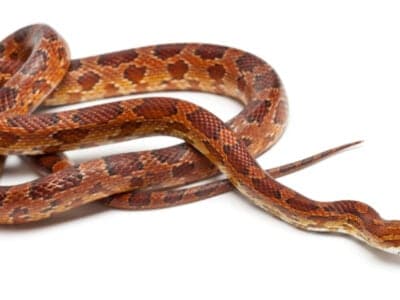
Rat Snakes
Rat snakes are constrictors from the Colubridae family of snakes.

Rooster
Will mate with the entire flock!
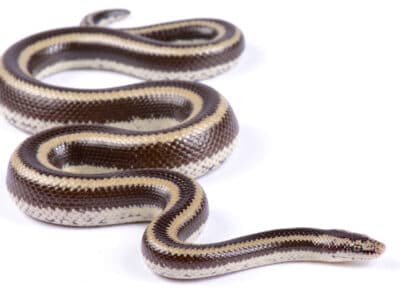
Rosy Boa
One of the few snakes that naturally comes in a rainbow of colors!
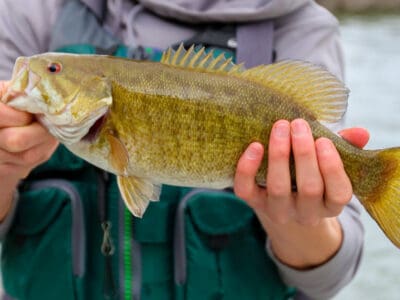
Smallmouth Bass
A fierce fighter!

Smokybrown Cockroach
Has up to 45 eggs per egg case
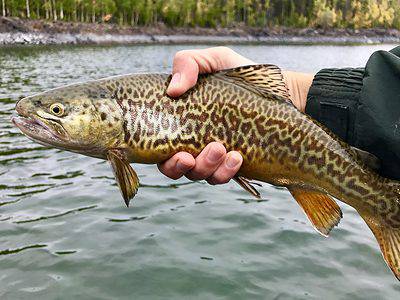
Tiger Trout
As tiger trout are sterile, they cannot produce offspring. However, they do have relatively long lifespans and can live up to 10 years in captivity.
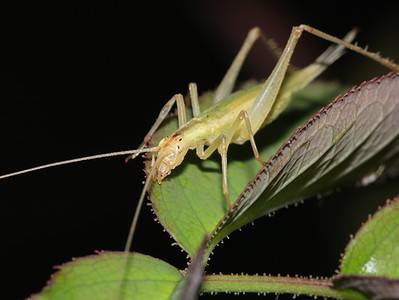
Tree Cricket
They make music with their wings
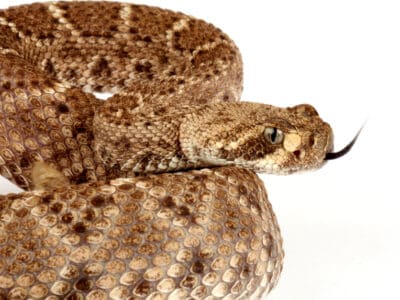
Western Diamondback Rattlesnake
They replace their fangs 2-4 times per year!
Nevadan Animals List
- Admiral Butterfly
- Beewolf wasp
- Blue Belly Lizard
- Boas
- Bull Trout
- Burrowing Owl
- Cactus Mouse
- Cactus Wren
- California Kingsnake
- Cinnamon Bear
- Common Yellowthroat
- Costa’s Hummingbird
- Dire Wolf
- Flea
- Harris’s Hawk
- Jackrabbit
- Kangaroo Mouse
- Kit Fox
- Kokanee Salmon
- MacGillivray’s Warbler
- Mealybug
- Milk Snake
- Mockingbird
- Mojave Rattlesnake
- Mountain Beaver
- Nematode
- Orb Weaver
- Owl
- Rainbow Grasshopper (Dactylotum bicolor)
- Rat Snakes
- Red Racer Snake
- Rooster
- Rosy Boa
- Sandhill Crane
- Sidewinder
- Smallmouth Bass
- Smokybrown Cockroach
- Swallowtail Butterfly
- Tiger Trout
- Tree Cricket
- Western Diamondback Rattlesnake
- Yellowish Cuckoo Bumblebee (formerly Fernald’s Cuckoo Bumblebee)
Animals in Nevada FAQs (Frequently Asked Questions)
What is the most dangerous animal in Nevada?
It is probably the bark scorpion.
What spiders are in Nevada?
The southwest is home to more than 1,000 species of spiders, and Nevada has its fair share of spider species. Some notable species include the California ebony tarantula, the venomous desert recluse, and the massive giant crab spider.
What predators are in Nevada?
Nevada has coyotes, mountain lions, bobcats, foxes, and wolves.
What kind of animals live in Reno?
Animals that live in Reno include raccoons, birds, squirrels, and rodents.
What rattlesnakes are in Nevada
Nevada is home to six types of rattlesnakes. They include the western diamondback, Mojave, speckled, Panamint, Mojave Desert sidewinder, and Great Basin rattlesnake.
What does the flag of Nevada look like?
Nevada adopted its current flag in 1991 and it comes with the inscription “battle born.”



